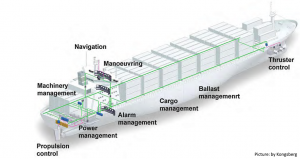On a ship there are many parameters that needs to be controlled or
monitored including: temperatures, pressure, level, viscosity, flow
control, position of vessel, speed, torque control, voltage, current,
machinery status (on/ off), and equipment status (open/ closed).
As the market is driving ship owners to become more efficient with
reduced staff on board it called for an automatic control and monitoring
system for the ship that enabled unattended operation of machinery
spaces. Vessels capable of safe operation at any period of time qualify
as UMS (Unattended Machinery Space) ships.
A modern automation and control system is a fully integrated systems
covering many aspects of the ship operation that includes the propulsion
plant operation, power management operation on the auxiliary engines,
auxiliary machinery operation, cargo on-and-off-loading operation,
navigation and administration of maintenance and purchasing of spares.

Propulsion (Main Engine) and Power (AuxiliaryEngines) Monitoring & Control
Monitoring and control of the ships propulsion and power is essential
for its efficiency and safety and there are many systems and parameters
to consider like: fuel consumption, combustion temperature, engine
temperature, diesel engine safety and start/stop, generator voltage and
frequency control, generator load in KW and %, load control, torque,
heavy consumers logic, control of diesel electric propulsion, thrusters
monitoring and control etc..
Automatic control of the starting of the main
engine can be done from the bridge as well as in Engine control room.
The automatic controls employed in starting the engine is by the
following sequence:
- Automatic control used in correctly positioning of the cam shaft.
- Admitting starting air
- Admitting fuel
- Starting air shut off
- Speed adjustment to the value required
Thus
the engine is started and the various parameters like temperature,
pressure, flow and tank level have to measured at every watch to make
sure that the engine is running safely.
Temperatures of lube oil, JCW, exhaust gas, etc. are measured.
Pressures of lube oil, JCW, fuel oil, and starting air etc. are measured.
Flow of fuel oil is measured while running.
Tank levels of Heavy fuel oil, diesel oil, and lube oil are measured.
For measuring the parameters we make use of the transducers, in turn sending the input signal to the automatic control system.
Auxiliary Machinery Monitoring and Control
Auxiliary machinery monitoring and control covers several systems
like: main sea & fresh water cooling system – pumps, system
pressure, temp. etc., Potable and fresh water control, Air compressors,
Bilge & sludge control – Tank level, pumps, Fuel oil system – Tank
levels, temp., viscosity, flow, purifiers, heaters etc., Other cooling
systems, Boiler/steam system – pumps, valves, pressure temp. etc., Air
Conditioning, ballast water treatment, exhaust gas treatment equipment.
This is employed in automatic starting and stopping of the auxiliary
generator from the engine control room. So of the automatic control used
are:
- Starting and stopping of the engine according to the load demand.
- Synchronization of incoming generator.
- Closing the circuit breaker
- Load sharing between the alternators
- Maintaining the supply frequency and voltage.
- Engine and alternator fault protection
- Preferential tripping of non-essential loads.
Cargo & Ballast Monitoring & Control
For safe on and off loading of cargo, especially on tankers, this
process is closely monitored and many times incorporates functions
like: Level gauging, Control of cargo pumps, Valve control, Ballast
& ballast pump control, Heeling control, Remote monitoring of
temperature, pressure, and flow.
Condition based monitoring
In order to further improve the ships efficiency many equipment
manufacturers are looking into feeding the main control and monitoring
system with opportunities for condition based monitoring. This would
further improve the possibilities of preventing breakdowns on board.
No comments:
Post a Comment